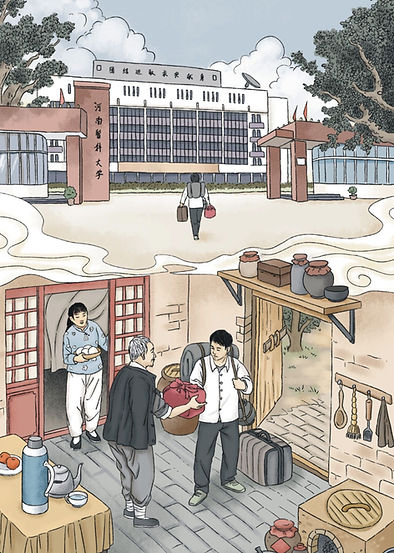
The Legacy of Li’s Poultice
Synopsis
Poultice therapy has a long history and has been passed down for generations. It is one of the five traditional dosage forms in Chinese medicine—poultices, powders, pills, elixirs, and decoctions. Known for its convenient use, lasting action, gentle nature, and affordability, poultice application has long been embraced by communities as part of traditional wellness practices. Because the traditional production techniques are complex and were historically transmitted orally from master to apprentice, fewer and fewer practitioners now possess this intangible cultural heritage skill. Many valuable historical formulas and methods risk being lost. For over a century, five generations of the Li family in Zhengzhou have persisted in preserving and refining their poultice-making knowledge, while also tracing its historical roots. Out of this cultural confidence came the creation of The Legacy of Li's Poultice, a richly illustrated work designed for easy reading and memory, bringing together the legacy of poultices through the ages and the Li family’s role in safeguarding this tradition.
Culture is the genetic code that sustains a nation’s vitality and development. Cultural confidence is the spiritual foundation for whether a person or community can continue its heritage and thrive. Both history and reality demonstrate that the prosperity of the Chinese nation over five millennia has relied on strong cultural and scientific creativity. The Li family of Zhengzhou created The Legacy of Li's Poultice as a concrete step to strengthen cultural confidence and to preserve and pass on this intangible cultural heritage. This book is intended for students, researchers, colleagues in the poultice field, and enthusiasts of Chinese medicine, offering value in learning about the history of external poultice use and understanding the richness of folk medicine traditions.
Chapter One
The Legacy of External Poultices
(Story 1 - 22)
The practice of applying medicated poultices has a history stretching back thousands of years. As one of the five classic forms of traditional Chinese preparations—alongside powders, pills, elixirs, and decoctions—it was valued in tradition for its convenient use, enduring form, perceived gentleness, and broad acceptance among the people.
Because the production process was intricate and often passed down orally from master to apprentice, many valuable recipes and techniques risked being lost over time. Yet the Li family of Zhengzhou, across five generations, has preserved and refined these skills, dedicating themselves to safeguarding this heritage through both practice and historical research.
Chapter Two
Culture and Confidence
(Story 23 - 32)
Culture forms the living foundation of a nation. Confidence in one’s cultural heritage is the precondition for continuity and growth. Chinese civilization has thrived for five millennia thanks to its strong creative power in both science and culture. The creation of The Legacy of Li's Poultice by the Li family is a contribution to cultural confidence—a visual and textual record that highlights the artistry, persistence, and values behind this traditional craft.
It serves not only as an educational resource for students, researchers, and practitioners, but also as an accessible introduction for anyone interested in understanding the history of external poultices and folk health practices.
Chapter Three
The Li Family’s Commitment
(Story 33 - 42)
For over a century, the Li family has remained steadfast in their role as guardians of this intangible cultural heritage. Their ongoing work includes collecting historical references, summarizing practical applications in traditional contexts, and teaching the craft to new generations. Their motivation comes not from economic gain, but from a profound sense of responsibility to cultural preservation and the well-being of communities.
Through both scholarship and practice, they have linked the ancient with the modern—transforming private family knowledge into a resource that benefits the wider world.
Chapter Four
A Bridge to the Future
(Story 43 - 49)
The story of poultices is not only about medicine; it is about resilience, craftsmanship, and cultural identity. By presenting The Legacy of Li's Poultice to international audiences, the Li family opens a dialogue between tradition and modernity, East and West.
This heritage continues to inspire, reminding us that the value of culture lies not only in supporting well-being, but also in sustaining memory, confidence, and continuity across generations.
Epilogue
Where there has been humanity, there has also been medicine. The development of traditional Chinese medicine (TCM) passed through distinct stages: the early period of food and medicine sharing the same origins; the era of shamans and physicians side by side; the theoretical foundation laid from the Spring and Autumn period (770–476 BCE) and the Warring States period (475–221 BCE) through the Qin (221–206 BCE) and Han dynasties (206 BCE–220 CE); the flourishing of medical texts during the later Han (25–220 CE), Jin (266–420 CE), and early Tang (618–907 CE); the debates of schools in the Song (960–1279 CE), Jin (1115–1234 CE), and Yuan (1271–1368 CE) dynasties; and the continued development during the Ming (1368–1644 CE) and Qing (1644–1912 CE) dynasties. Within the system of pattern differentiation and treatment, the formulation of prescriptions has always been a core element.
Throughout the millennia of TCM history, external therapies often played a leading role. Only when external methods were seen as less effective in practice did physicians consider internal prescriptions. By the time of the Republic of China (1912–1949 CE), as fee-for-service models spread, internal prescriptions gradually gained more prominence.



